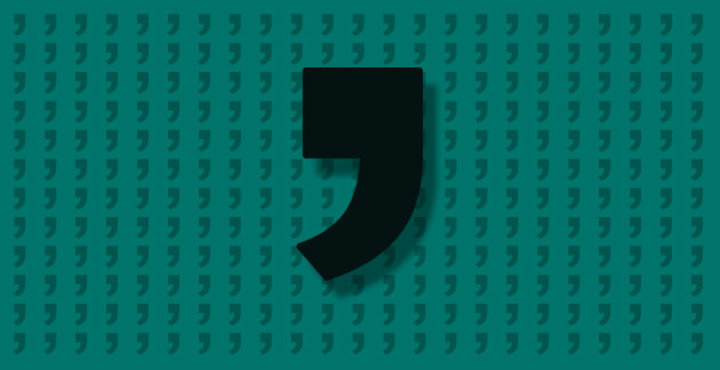In our earlier article we highlighted what the comma is and some of the common comma rules. In the process, we learned that commas remove ambiguity and ensure that readers understand the meaning the author wants to convey. Let's continue looking at some additional grammatical constructions that call for comma usage.
Using commas: Dates
A comma separates the month and date from the year.
On March 23, 2009, David and Alice will be married.
However, if the date is written in the inverted style, or if only the month and year are given, no comma is needed.
The new law goes into effect 30 May 2010.
October 2006 was the month we went over our budget.
Using commas: Addresses
Street address, city, and state are separated by commas.
I am moving to 45 Magnolia Lane, Toronto, Ontario.
Using commas: Titles
If a title follows a name, a pair of commas separates it from the rest of the sentence.
Michael Smith, paleontologist, will lead the excavation.
Using commas: Numbers
In numbers longer than four digits, commas separate the numbers into groups of three, starting from the right side.
15,000
10,000,000
This convention is predominantly found in North American and British English. Numbers may be punctuated differently in other languages.
Using commas: Coordinate adjectives (but not cumulative adjectives)
Coordinate adjectives are adjectives that modify a noun on their own. Commas separate two or more coordinate adjectives.
It's going to be a long, hot, busy summer.
Cumulative adjectives depend on one another for meaning. Do not use commas to separate two or more cumulative adjectives.
Three large red trucks were headed for the entrance ramp.
What if you aren't sure whether you're dealing with coordinate or cumulative adjectives? Scribendi's editing services suggest trying these two tests:
- If you insert the word and between the adjectives, does the sentence still make sense?
- If you list the adjectives in a different order, does the sentence still make sense?
If you answered yes, you have a list of coordinate adjectives, and they should be separated by commas. If you answered no, you have a list of cumulative adjectives, and they should not be separated by commas.
Using commas: Non-restrictive appositives (but not restrictive appositives)
An appositive is a noun or noun phrase that renames a nearby noun. The need for commas around an appositive depends on whether it is restrictive or non-restrictive.
A non-restrictive appositive is a phrase that restates information already given.
My oldest son, Michael, won the race.
The phrase my oldest son can only refer to one person, so the addition of his name is not necessary for us to understand the meaning of the sentence. The appositive could be removed, and we would still know who won the race. Commas are used to set apart non-restrictive appositives.
A restrictive appositive is a phrase that clarifies an ambiguity in the information already given.
Shakespeare's play Romeo and Juliet is a classic tale of forbidden love.
Since Shakespeare wrote more than one play, we need the appositive Romeo and Juliet to clarify which play the author is discussing. If the appositive were removed, the meaning of the sentence would be unclear. Commas are not used to set apart restrictive appositives.
Using commas: Ensuring clarity
Commas can ensure clarity and eliminate wordiness. Sometimes a comma will prevent what grammarians call mistaken junctions, when a reader groups words in a way other than the author intended. Notice the difference in clarity when commas are used properly:
- Soon after the dinner was interrupted by a robbery.
- Soon after, the dinner was interrupted by a robbery.
- She saw the spider that climbed the wall and gasped.
- She saw the spider that climbed the wall, and gasped.
- To Sally Frank was an insufferable person.
- To Sally, Frank was an insufferable person.
To sum it all up...
The comma is a powerful punctuation mark with an impressive array of uses. No matter how the comma is used, its purpose is to make the meaning clear. Authors struggling with a gray area of comma usage should consider the meaning they hope to convey and make the choice that seems best.
Remember, clarity always wins out over strict adherence to comma rules.










